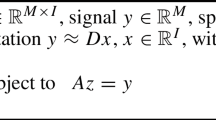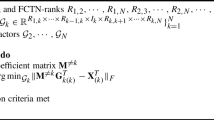Abstract
Incomplete multi-view clustering (IMC) has achieved widespread attention due to its advantage in fusing the multi-view information when the view samples are unobserved partly. Recently, it is shown that the clustering performance in the subspace can be improved by preserving the clustering structure of each view, but the problem of the inconsistent clustering structure caused by the incomplete graphs are seldom considered, restricting the clustering performance. Motivated by the clustering interpretation of the orthogonal non-negative matrix factorization, it is employed to unify the clustering structure of the data, and a new model called Incomplete Graph-regularized Orthogonal Non-negative Matrix Factorization (IGONMF) is proposed in this paper. In IGONMF, the reproduced representation is developed, based on which, a set of incomplete graphs are utilized to fully take advantage of the geometric structure of the data. And the orthogonality is further employed to alleviate the problem of the inconsistent clustering structure. Also, we design an effective iterative updating algorithm to solve the proposed model, along with its analysis on the convergence and the computational cost. Finally, experimental results on several real-world datasets indicate that our method is superior to the related state-of-the-art methods.













Similar content being viewed by others
References
Khan A, Maji P (2021) Approximate graph laplacians for multimodal data clustering. IEEE Trans Pattern Anal Mach Intell 43(3):798–813. https://doi.org/10.1109/TPAMI.2019.2945574
Sun D, Toh K-C, Yuan Y (2021) Convex clustering: Model, theoretical guarantee and efficient algorithm. J Mach Learn Res 22(9):1–32. http://jmlr.org/papers/v22/18-694.html
Li X, Zhang R, Wang Q, Zhang H (2021) Autoencoder constrained clustering with adaptive neighbors. IEEE Trans Neural Netw Learn Syst 32(1):443–449. https://doi.org/10.1109/TNNLS.2020.2978389
Wang Z, Li Z, Wang R, Nie F, Li X (2021) Large graph clustering with simultaneous spectral embedding and discretization. IEEE Trans Pattern Anal Mach Intell 43(12):4426–4440. https://doi.org/10.1109/TPAMI.2020.3002587
Yang Z, Li Q, Liu W, Lv J (2020) Shared multi-view data representation for multi-domain event detection. IEEE Trans Pattern Anal Mach Intell 42(5):1243–1256. https://doi.org/10.1109/TPAMI.2019.2893953>
Chao G, Sun S, Bi J (2021) A survey on multiview clustering. IEEE Trans Artif Intell 2(2):146–168. https://doi.org/10.1109/TAI.2021.3065894
Zhang X, Yang Y, Li T, Zhang Y, Wang H, Fujita H (2021) CMC: A consensus multi-view clustering model for predicting alzheimer’s disease progression. Comput Methods Programs Biomed 199:105895. https://doi.org/10.1016/j.cmpb.2020.105895
Wang Q, Chen M, Nie F, Li X (2020) Detecting coherent groups in crowd scenes by multiview clustering. IEEE Trans Pattern Anal Mach Intell 42(1):46–58. https://doi.org/10.1109/TPAMI.2018.2875002
Peng B, Lei J, Fu H, Shao L, Huang Q (2020) A recursive constrained framework for unsupervised video action clustering. IEEE Trans Ind Inf 16(1):555–565. https://doi.org/10.1109/TII.2019.2937514
Zhang Z, Zhai Z, Li L (2017) Uniform projection for multi-view learning. IEEE Trans Pattern Anal Mach Intell 39(8):1675–1689. https://doi.org/10.1109/TPAMI.2016.2601608
Ma F, Meng D, Dong X, Yang Y (2020) Self-paced multi-view co-training. J Mach Learn Res 21(57):1–38. http://jmlr.org/papers/v21/18-794.html
Khan A, Maji P (2021) Multi-manifold optimization for multi-view subspace clustering. IEEE Transactions on Neural Networks and Learning Systems. https://doi.org/10.1109/TNNLS.2021.3054789
Nie F, Cai G, Li J, Li X (2018) Auto-weighted multi-view learning for image clustering and semi-supervised classification. IEEE Trans Image Process 27(3):1501–1511. https://doi.org/10.1109/TIP.2017.2754939
Wang H, Yang Y, Liu B (2020) GMC: graph-based multi-view clustering. IEEE Trans Knowl Data Eng 32(6):1116–1129. https://doi.org/10.1109/TKDE.2019.2903810
Li X, Zhang H, Wang R, Nie F (2022) Multiview clustering: A scalable and parameter-free bipartite graph fusion method. IEEE Trans Pattern Anal Mach Intell 44(1):330–344. https://doi.org/10.1109/TPAMI.2020.3011148
Zhan K, Nie F, Wang J, Yang Y (2019) Multiview consensus graph clustering. IEEE Trans Image Process 28(3):1261–1270. https://doi.org/10.1109/TIP.2018.2877335
Wang H, Yang Y, Liu B, Fujita H (2019) A study of graph-based system for multi-view clustering. Knowl Based Syst 163:1009–1019. https://doi.org/10.1016/j.knosys.2018.10.022
Li Z, Zhao H, Guo Y, Yang Z, Xie S (2021) Accelerated log-regularized convolutional transform learning and its convergence guarantee. IEEE Transactions on Cybernetics. https://doi.org/10.1109/TCYB.2021.3067352
Zhang B, Qiang Q, Wang F, Nie F (2022) Fast multi-view semi-supervised learning with learned graph. IEEE Trans Knowl Data Eng 34(1):286–299. https://doi.org/10.1109/TKDE.2020.2978844
Yi Z, Yang Y, Li T, Fujita H (2019) A multitask multiview clustering algorithm in heterogeneous situations based on LLE and LE. Knowl Based Syst 163:776–786. https://doi.org/10.1016/j.knosys.2018.10.001
Yang Z, Zhang Y, Xiang Y, Yan W, Xie S (2020) Non-negative matrix factorization with dual constraints for image clustering. IEEE Trans Syst Man Cybern: Syst 50(7):2524–2533. https://doi.org/10.1109/TSMC.2018.2820084
Wang J, Tian F, Yu H, Liu C H, Zhan K, Wang X (2018) Diverse non-negative matrix factorization for multiview data representation. IEEE Trans Cybern 48(9):2620–2632. https://doi.org/10.1109/TCYB.2017.2747400
Liang N, Yang Z, Li Z, Sun W, Xie S (2020) Multi-view clustering by non-negative matrix factorization with co-orthogonal constraints. Knowl-Based Syst 194:105582. https://doi.org/10.1016/j.knosys.2020.105582
Wang X, Zhang T, Gao X (2019) Multiview clustering based on non-negative matrix factorization and pairwise measurements. IEEE Trans Cybern 49(9):3333–3346. https://doi.org/10.1109/TCYB.2018.2842052
Yang Z, Liang N, Yan W, Li Z, Xie S (2021) Uniform distribution non-negative matrix factorization for multiview clustering. IEEE Trans Cybern 51(6):3249–3262. https://doi.org/10.1109/TCYB.2020.2984552
Zhao W, Xu C, Guan Z, Liu Y (2021) Multiview concept learning via deep matrix factorization. IEEE Trans Neural Netw Learn Syst 32(2):814–825. https://doi.org/10.1109/TNNLS.2020.2979532
Wang D, Han S, Wang Q, He L, Tian Y, Gao X (2021) Pseudo-label guided collective matrix factorization for multiview clustering. IEEE Transactions on Cybernetics. https://doi.org/10.1109/TCYB.2021.3051182
Xu C, Tao D, Xu C (2015) Multi-view learning with incomplete views. IEEE Trans Image Process 24(12):5812–5825. https://doi.org/10.1109/TIP.2015.2490539
Zhang C, Adeli E, Wu Z, Li G, Lin W, Shen D (2019) Infant brain development prediction with latent partial multi-view representation learning. IEEE Trans Med Imaging 38(4):909–918. https://doi.org/10.1109/TMI.2018.2874964
Chao G, Sun J, Lu J, Wang A-L, Langleben DD, Li C- R, Bi J (2019) Multi-view cluster analysis with incomplete data to understand treatment effects. Inf Sci 494:278–293. https://doi.org/10.1016/j.ins.2019.04.039
Trivedi A, Rai P, Daumé III H, DuVall S L (2010) Multiview clustering with incomplete views. In: In Advances in neural information processing systems
Li S-Y, Jiang Y, Zhou Z-H (2014) Partial multi-view clustering. In: Proceedings of the Twenty-Eighth AAAI Conference on Artificial Intelligence, Québec City, Québec, pp 1968– 1974
Shao W, He L, Yu P S (2015) Multiple incomplete views clustering via weighted nonnegative matrix factorization with L2,1 regularization. In: Machine Learning and Knowledge Discovery in Databases - European Conference, Porto. https://doi.org/10.1007/978-3-319-23528-8_20, pp 318–334
Hu M, Chen S (2018) Doubly aligned incomplete multi-view clustering. In: Proceedings of the Twenty-Seventh International Joint Conference on Artificial Intelligence, Stockholm, Sweden. https://doi.org/10.24963/ijcai.2018/313, pp 2262–2268
Liang N, Yang Z, Li Z, Xie S, Su C-Y (2020) Semi-supervised multi-view clustering with graph-regularized partially shared non-negative matrix factorization. Knowl-Based Syst 190:105185. https://doi.org/10.1016/j.knosys.2019.105185
Wen J, Zhang Z, Xu Y, Zhang B, Fei L, Liu H (2019) Unified embedding alignment with missing views inferring for incomplete multi-view clustering. In: The Thirty-Third AAAI Conference on Artificial Intelligence, Honolulu, Hawaii, USA. https://doi.org/10.1609/aaai.v33i01.33015393, pp 5393–5400
Wen J, Yan K, Zhang Z, Xu Y, Wang J, Fei L, Zhang B (2021) Adaptive graph completion based incomplete multi-view clustering. IEEE Trans Multim 23:2493–2504. https://doi.org/10.1109/TMM.2020.3013408
Yang L, Shen C, Hu Q, Jing L, Li Y (2020) Adaptive sample-level graph combination for partial multiview clustering. IEEE Trans Image Process 29:2780–2794. https://doi.org/10.1109/TIP.2019.2952696
Rai N, Negi S, Chaudhury S, Deshmukh O (2016) Partial multi-view clustering using graph regularized NMF. In: 23rd International Conference on Pattern Recognition, Cancún, Mexico. https://doi.org/10.1109/ICPR.2016.7899961, pp 2192–2197
Wen J, Zhang Z, Zhang Z, Fei L, Wang M (2021) Generalized incomplete multiview clustering with flexible locality structure diffusion. IEEE Trans Cybern 51(1):101–114. https://doi.org/10.1109/TCYB.2020.2987164
Lee D D, Seung H S (1999) Learning the parts of objects by non-negative matrix factorization. Nature 401(6755):788–791
Ding C, Li T, Peng W, Park H (2006) Orthogonal nonnegative matrix t-factorizations for clustering. In: Proceedings of the Twelfth ACM SIGKDD International Conference on Knowledge Discovery and Data Mining. https://doi.org/10.1145/1150402.1150420, Philadelphia, pp 126–135
Li B, Zhou G, Cichocki A (2015) Two efficient algorithms for approximately orthogonal nonnegative matrix factorization. IEEE Signal Process Lett 22(7):843–846. https://doi.org/10.1109/LSP.2014.2371895
Li Z, Wu X, Peng H (2010) Nonnegative matrix factorization on orthogonal subspace. Pattern Recogn Lett 31(9):905–911. https://doi.org/10.1016/j.patrec.2009.12.023
Ma L, Li H, Meng F, Wu Q, Ngan K N (2017) Learning efficient binary codes from high-level feature representations for multilabel image retrieval. IEEE Trans Multimed 19(11):2545–2560. https://doi.org/10.1109/TMM.2017.2703089
Tao H, Hou C, Yi D, Zhu J (2020) Multiview classification with cohesion and diversity. IEEE Trans Cybern 50(5):2124–2137. https://doi.org/10.1109/TCYB.2018.2881474
Liang N, Yang Z, Li Z, Xie S, Sun W (2021) Semi-supervised multi-view learning by using label propagation based non-negative matrix factorization. Knowl-Based Syst 228:107244. https://doi.org/10.1016/j.knosys.2021.107244
Demsar J (2006) Statistical comparisons of classifiers over multiple data sets. J Mach Learn Res 7:1–30. http://jmlr.org/papers/v7/demsar06a.html
Author information
Authors and Affiliations
Corresponding author
Additional information
Publisher’s note
Springer Nature remains neutral with regard to jurisdictional claims in published maps and institutional affiliations.
This article belongs to the Topical Collection: Special Issue on Multi-view Learning
Guest Editors: Guoqing Chao, Xingquan Zhu, Weiping Ding, Jinbo Bi and Shiliang Sun
This work was supported in part by the Key-Area Research and Development Program of Guangdong Province under Grants 2019B010154002, 2019B010118001, and 2019B010121001; in part by the National Natural Science Foundation of China under Grants 61803096, 61801133, and U191140003; in part by the Guangzhou Science and Technology Program Project under Grant 202002030289; in part by the Guangdong Natural Science Foundation under Grant 2022A1515010688.
Rights and permissions
About this article
Cite this article
Liang, N., Yang, Z., Li, Z. et al. Incomplete multi-view clustering with incomplete graph-regularized orthogonal non-negative matrix factorization. Appl Intell 52, 14607–14623 (2022). https://doi.org/10.1007/s10489-022-03551-y
Accepted:
Published:
Issue Date:
DOI: https://doi.org/10.1007/s10489-022-03551-y




